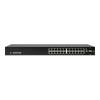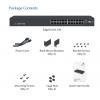-
€


EdgeSwitch 24-Lite e' un switch di gestione di Ubiquiti. Dotato di 24 gigabit porte Ethernet e 2 slot per SFP. Ha la funzionalita' di un interruttore Layer2 e possibilita' di routing Layer3 (solo routing statico e policy-based). Adatto per l'uso in reti con alta capacita', offre alta efficienza e tanti funzioni di gestione. Ha un'alimentatore integrato, puo' essere alimentato direttamente dalla presa, e' dotato anche di una spina DC (16-25V, 56W, spina 2,5mm). Due fonti di alimentazione possono funzionare in modo ridondante.
Capacita' totale (non-blocking) e' 26Gb/s, velocita' di commutazione e' 52Gb/s, e velocita' di trasferimento 38,69Mpps. Il dispositivo offre funzioni come: MSTP/RSTP/STP, VLAN, Private VLAN, Voice VLAN, Link Aggregation, DHCP Snooping, IGMP Snooping, DiffServ, server DHCP e tanti altri. Gestione viene via interfaccia grafica o linea di comando CLI (disponibili attraverso la porta console, telnet o SSH).
Switch ha una custodia adatta per montaggio in armadi Rack 19", orecchie sono inclusi nel set.
Caratteristiche principali:
- 24 gigabit porte Ethernet;
- 2 slot per SFP;
- capacita' totale (non-blocking) 26 Gb/s;
- capacita' di switch 52 Gb/s;
- velocita' di trasferimento: 38,69 Mpps;
- gestione via interfaccia grafica o CLI;
- due fonti di alimentazione (possono funzionare in modo ridondante);
- custodia adatta per montaggio in armadi Rack.
Specifiche:
| ES-24-Lite | |
| Capacita' totale | 26 Gb/s |
| Capacita' di switch | 52 Gb/s |
| Velocita' di trasferimento | 38,69 Mpps |
| Potenza massima assorbita | 25 W |
| Metodi di alimentazione |
AC: 100-240V AC/50-60 Hz DC: 16-25V, 25W (spina DC 2,5 mm) |
| Alimentatore | Integrato |
| LED su porta |
Consolle: - RJ45: Speed/Link/Activity SFP: Speed/Link/Activity |
| Interfaccia di rete |
24x gigabit porta Ethernet 10/100/1000 Mb/s 2x SFP |
| Interfaccia di gestione |
1x porta RJ45 Ethernet In/Out Band |
| Dimensioni | 443x43x221 mm |
| Peso | 2,6 kg |
| Possibilita di montaggio in armadi Rack | Si, altezza 1U |
| Certificati | CE, FCC, IC |
| Ochrona ESD/EMP | 24 kV |
| Ammessa temperatura di lavoro | Da -5 a 40 gradi |
| Umidita' ammessa | 5%-95% non condensa |
| Vibrazioni | ETSI300-019-1.4 |
| Software | |
|---|---|
| Funzioni principali di switch |
ANSI / TIA-1057: LLDP-Media Endpoint Discovery (MED) IEEE 802.1AB: Link Layer Discovery Protocol (LLDP) IEEE 802.1D: Spanning Tree Compatibility IEEE 802.1S: Multiple Spanning Tree Compatibility IEEE 802.1W: Rapid Spanning Tree Compatibility IEEE 802.1Q: Virtual LANs with Port-Based VLANs IEEE 802.1p: Ethernet Priority with User Provisioning and Mapping IEEE 802.1X: Port-Based Authentication with Guest VLAN Support IEEE 802.3: 10BASE-T IEEE 802.3u: 100BASE-T IEEE 802.3ab: 1000BASE-T IEEE 802.1ak: Virtual Bridged Local Area Networks - Amendment 07: Multiple Registration Protocol IEEE 802.3ac: VLAN Tagging IEEE 802.3ad: Link Aggregation IEEE 802.3x: Flow Control IEEE 802.1D-2004: Generic Attribute Registration Protocol: Clause 12 (GARP) IEEE 802.1D-2004: Dynamic L2 multicast registration: Claue 10 (GMRP) IEEE 802.1Q-2003: Dynamic VLAN registration: Clause 11,2 (GVRP) RFC 4541: considerations for Internet Group Management Procotl (IGMP) Snooping switches RFC 5171: Unidirectional Link Detection (UDLD) Protocol |
| Funzioni avvanzate Layer2 |
Broadcast storm recovery Broadcast/multicast/unknow unicast storm recovery DHCP Snooping IGMP Snooping Querier Independent VLAN Learning (IVL) Jumbo Ethernet Frame Port MAC Locking Port Mirroring Protected Ports Static MAC Filtering TACACS+ Voice VLANs Unauthenticated VLAN Internal 802.1X Authentication Server |
| Specifiche di piattaforma |
DHCP Server:
Routing:
VLANs: 255 MAC Addresses: 8k MSTp Instances: 4 LAGs: 6 ACLs: 100 with 10 rules per port Traffic Classes (queues): 8 |
| Funzioni di sistema |
Event and Error Loggign Facility Run-Time and configuration download capability PING Utility FTP/TFTP trasfers via IPv4/IPv6 Malicious Code Detection BootP and DHCP RFC 2021: Remote Network Monitoring Management Information Base Version 2 RFC 2030: Simple Network Time Protocol (SNTP) RFC 2819: Remote Network Monitoring Management Information Base RFC 2865: RADIUS Client RFC 2866: RADIUS Accounting RFC 2868: RADIUS Attributes for Tunnel Protocol Support RFC 2869: RADIUS Extensions RFC 3579: RADIUS Support for EAP RFC 3580: IEEE 802.1X RADIUS Usage Guidelines RFC 3164: BSD Syslog Protocol |
| Gestione |
Web UI Industry-Standard CLI IPv6 Management Password Management Autoinstall Support for Firmware Images and Configuration Files SNMP v1, v2 and v3 SSH 1.5 and 2.0 SSL 3.0 and TLS 1.0 Secure Copy (SCP) Telnet (Multi-Session Support) |
| Routing Layer3 |
Static routing Policy based routing |
| QoS |
Access Control Lists (ACLs), Permi/Deny actions for ibound IP and Layer2 traffic classification based on:
Optional ACL rule attributes:
Differentiated Services (DiffServ):
Class of Service (CoS) queue mapping configuration:
|






 Polski
Polski English
English Italiano
Italiano Español
Español Čeština
Čeština Српски
Српски Deutsch
Deutsch Ελληνικά
Ελληνικά Slovenský
Slovenský









